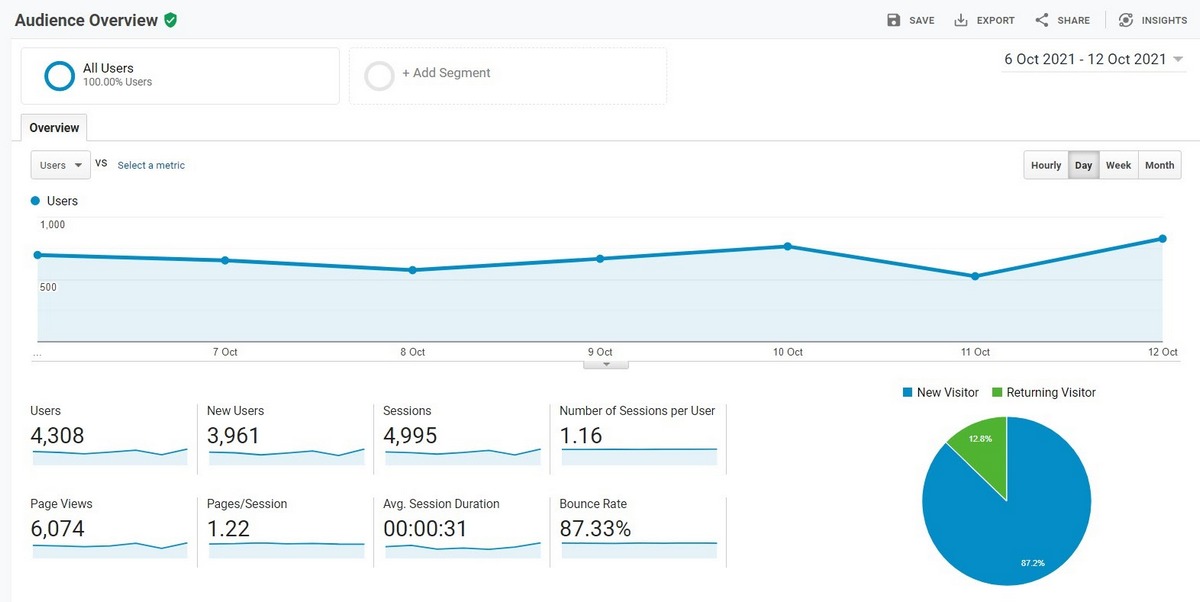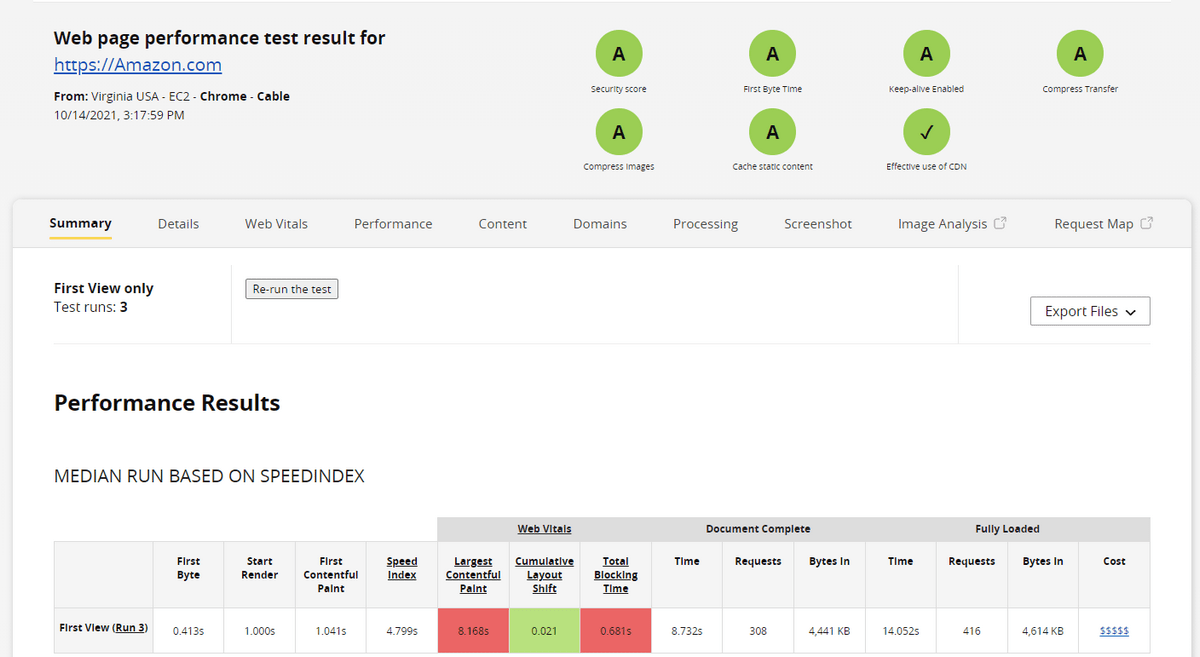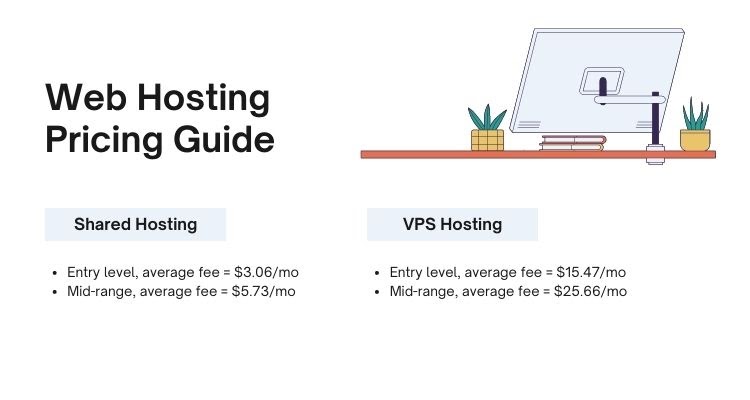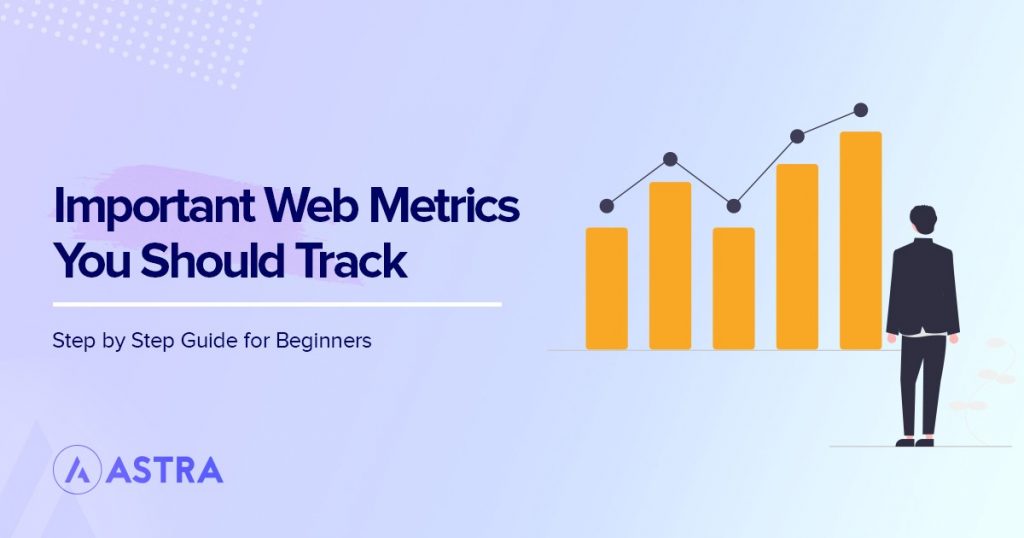Website metrics refer to data you can use to monitor the performance of your website. Don’t mistake the term “performance” as simply referring to speed, though. Metrics can help you understand and improve everything from traffic volume to lead conversion.
The biggest challenge today isn’t collecting data – there are many tools capable of doing that automatically.
Choosing the correct data to analyze and understanding how you can use it is the crucial differentiating factor.
The Importance of Website Performance
There are over 1.88 billion websites in the world today, but studies indicate that more than 90% of web pages get no organic traffic. That’s a massive problem from a website owner’s viewpoint since content costs money to produce.
As website owners, we have so many things to focus on that doing work that produces no result is a tragic waste of precious resources.
To further drive home the point of how metrics can help you improve website performance, let’s consider the case of automaker BMW.
By improving mobile site performance, the company increased traffic to their sales site from 8% to 30%. The improvements BMW gained resulted from data-driven enhancements based on website metrics.
If you want to improve your website performance, you’ll need to know what data to track and how it can help.
Key Website Performance Metrics to Watch
Here are what we consider the most important website performance metrics to monitor.
1. Website Traffic

Website traffic comes in a number of types, including organic, direct, referral, paid and social traffic.
Understanding the different types of traffic and their web page metrics helps you analyze and optimize all sources for better conversion.
Let’s first understand the different types of web traffic you can get.
Organic Traffic
Organic traffic comes from search engines such as Google, Bing, or Yahoo. This is considered to be high quality traffic because it comes from search engines without any paid promotion or advertising.
Organic search drives 53% of website traffic, while paid search drives 15%.
Receiving organic traffic means visitors are actively searching for content related to your website and search engines are recommending your content to them.
Direct Traffic
Direct traffic arrives by typing your URL into the browser or by clicking on a bookmark.
Such traffic is also considered to be high quality traffic as your visitors are intentionally seeking out your website.
They are highly influenced by offline marketing efforts such as print or radio as well as online brand awareness such as social media campaigns.
Direct traffic is an important metric to provide insights into brand awareness and customer loyalty.
Referral Traffic
Visitors that come to your website from another website are called referrals. It can either be a social media platform, a blog post, or other websites that have links to your website.
It brings new visitors who might have just discovered your site otherwise.
You can build referral traffic by focusing on building relationships with other websites through guest posting, and actively participating in social media communities.
Paid Traffic
Visitors who visit your website from paid advertising campaigns like Google Ads or Facebook Ads are paid traffic.
Statistics show that paid search ads drive an average of 65% of website clicks for high intent keyword searches.
Paid traffic is targeted based on a variety of factors including geographic location, interests, and search keywords.
To get the most out of paid traffic, you should ideally have a solid understanding of your target audience and the best ways to reach them.
Social Traffic
Visitors coming to your website from social media platforms like Facebook, Twitter, Instagram, and LinkedIn are classed as social traffic.
Social media channels are a major source of website traffic, driving most referral traffic to websites.
A social media presence helps you reach new audiences and increase brand awareness as well as providing their own channels for engagement. It’s why social media marketing is so important.
Which Is the Most Important Traffic?
The most important website traffic depends upon the goals and objectives of your website.
For example, if you own an eCommerce website, you might prioritize direct traffic and organic search traffic.
If you manage a content-focused website, you might prioritize social traffic and referral traffic.
However, organic traffic is considered to be one of the most important types as it can lead to more conversions.
Some key statistics related to organic search traffic:
- Organic search drives the majority of website traffic for most websites accounting for an average of 53% of all website traffic, according to a study by BrightEdge.
- Websites that rank in the top 3 organic search results for a given keyword receive an average click-through rate (CTR) of 36.4%, according to a study by Ignite Visibility.
- The average conversion rate for organic search traffic is 16%, compared to 4% for paid search traffic, according to a study by WebFX.
All these stats highlight the importance of organic search traffic for your website.
2. Page Speed
Page speed refers to how quickly a web page loads and renders its content, including images, videos, and text.
It is an important website metric for determining your website performance and user experience.
Slow page speed leads to higher bounce rates, low user engagement, and reduced conversions.
Why Page Speed Matters
Page speed is an important metric impacting user experience, search engine ranking, and website performance as a whole.
A slow-loading website can lead to a poor user experience, with your visitors becoming frustrated and leaving the website before engaging with its content.
With better page speed, you can create a faster and mobile friendly experience.
Search engines like Google use page speed as a ranking factor, with faster websites ranking higher in search results.
With the increasing use of mobile devices, it’s essential your website has a good page speed across all devices.
How to Check Page Speed
There are a number of tools available to check website page speed.
Here are some popular options:
Google PageSpeed Insights
The tool provided by Google offers a comprehensive analysis of your website’s page speed. It also suggests ways to improve it should that be necessary.
To use it, you can simply enter your website URL and run the analysis.
GTmetrix
GTmetrix is a page speed tool providing a detailed analysis of your website page speed.
It includes metrics such as page load time, page size, and the number of requests. It also provides recommendations for improving your website’s page speed similar to Google.
Pingdom
Pingdom offers a website speed test to analyze page speed and offers a report with performance insights and recommendations.
It also provides a waterfall chart showing how your website loads and where improvements can be made.
WebPageTest
WebPageTest is a free tool offering a detailed analysis of website page speed.
Options include a waterfall chart, video playback of the page loading, and a few recommendations for improving the speed.
3. Average Pages Per Person
Average pages per person is a common website metric to understand how visitors are engaging with your content.
It varies on the website’s purpose, content, and audience.
Generally, the average number of pages per person is around 2-3. It implies that the visitors will view 2-3 pages during their session.
A news website or a blog may have a higher average number of pages per person as visitors may read multiple articles during a session.
An eCommerce website may have a lower average as visitors may only view a few product pages before making a purchase.
Why Average Pages Per Person Matters
Average pages per person is an indicator of user engagement.
A higher number of pages per person suggests that your visitors are finding your content interesting and engaging. A lower number may indicate that the website might not be meeting their needs.
Average pages per person also helps you measure the effectiveness of your content.
If your visitors are only viewing a few pages before leaving, it may imply that the content is not relevant or engaging enough to keep them on your website.
A higher number of pages per person has a positive impact on revenue potential. The more your visitors are engaged on your website, the more likely they will convert into customers or take other desired actions.
SEO is yet another factor that is being impacted by average pages per person. Search engines take user engagement signals into account when determining search rankings.
How to Measure Average Pages Per Person
To measure the average pages per person on your website, you can use website analytics tools such as Google Analytics.
Here’s how:
- Set up Google Analytics: Create a Google Analytics account and add the tracking code to your website.
- Navigate to the Behavior report: In Google Analytics, navigate to the Behavior section and select Overview.
- View the pages per session metric: The Overview report will show you several metrics, including the average number of pages per session. This metric represents the average number of pages viewed by a visitor during a single session on your website.
- Segment the data: To get a more detailed view of the average pages per person, you can segment the data by the audience. For example, you can view the average pages per person for new visitors versus returning visitors or for visitors from different geographic regions.
- Set goals: Setting goals for your website can help you track the effectiveness of your content and improve the average pages per person metric. For example, if you want to encourage visitors to view more pages, you could set a goal to increase the average pages per person to 3 pages per session.
By measuring the average pages per person on your website, you can gain insights into how visitors are engaging with your content.
Bonus: Using Heatmaps to Track User Behavior
When it comes to tracking user behavior, heatmaps are a popular tool. They identify the areas of a page that generate the most engagement, or heat.
It uses color coding to show the level of activity or engagement on different sections of a website, allowing you to identify which areas are most popular and cost-effective.
Here are the steps for using heatmaps to track user behavior and heat generated in different website sections:
- Choose a heatmap tool: There are several heatmap tools available! The two most popular are Microsoft Clarity and Hotjar.
- Install the heatmap tool: Once you have chosen a heatmap tool, install the tracking code on your website. This will allow the tool to track user behavior and generate heatmaps.
- Analyze the heatmap data: Once the tracking code is installed, the heatmap tool will begin tracking user behavior and generating heatmaps. It analyzes the data to identify areas of high engagement such as sections of the website where users are clicking or spending the most time.
- Make changes based on the heatmap data: Once you have identified areas of high engagement, you can make changes to your website to optimize these sections. For example, if users are spending a lot of time on a particular page but not converting, you may want to experiment with different calls to action or design elements to encourage more conversions.
- Test and refine: After making changes based on the heatmap data, continue to monitor the data and refine your website to improve engagement and heat generation. This could include A/B testing different variations of a page or element to see which performs better.
By using heatmaps to track user behavior and heat generated in different website sections, you can gain valuable insights.
You can see how visitors are interacting with your website and make data-driven decisions to optimize the user experience and improve conversion rates.
Why Website Traffic Matters
As website traffic increases, it places increasing pressure on web hosting resources like processor time (CPU) and memory (RAM). Over-taxing these resources can lead to erratic website performance like slower page loads or pages simply refusing to load.
How to Track Website Traffic Analytics
There are many tools available to track website traffic, but one of the best is Google Analytics. It’s a relatively comprehensive solution that tracks various metrics, including the number of visitors your website sees.
It’s free and pretty easy to implement on any website.
If Google Analytics isn’t your cup of tea, there are other website traffic monitoring solutions available, including:
1. Time to First Byte

Each time a visitor types your domain name into their web browser and hits the enter key, a request goes from the browser to your web server. On receipt, the web server will acknowledge the request with a response.
Time to First Byte (TTFB) is the time between sending that initial request and the browser receiving a response.
Why TTFB Matters
TTFB affects your website in a few ways. Taken at face value, it’s a good indicator as to the quality of your web hosting service provider.
When we purchase a web hosting plan, the information we see is generic.
For example, a web host may advertise the amount of resources available on a hosting plan but not the specifics of their equipment. It’s similar to buying a car without knowing the make or model – simply that it has four wheels and moves.
To reduce TTFB, you’ve got to improve several aspects of your website performance. However, one that’s super important is the server quality. To better your server performance, you’ve got to either upgrade to a better hosting plan or shift to an alternative WordPress hosting provider

Based on a detailed web hosting cost comparison, the cost of an entry-level shared hosting is around $3.06/mo, while a more powerful VPS hosting will cost you around $15.47/mo.
How to Check TTFB (Tools)
Many tools can check server response times and offer a variety of associated data.
They offer varying amounts of information, from the basic to the highly detailed. One tool that provides the latter is WebPageTest, with information on everything from TTFB to complete waterfall charts.
You can also try others like:
2. Uptime
Uptime refers to the amount of time that your website is available to visitors. While we can take website uptime from an application viewpoint, the main focus should be on the web hosting server.
If the hosting server goes down, our websites won’t be accessible.
Why Uptime Matters
The most direct impact of a web hosting server that goes down is the potential impact on earnings. This impact can be extremely harmful on highly commercial websites like eCommerce stores.
Even worse is the potential for reputational damage to your brand.
Studies indicate that as many as 9% of website visitors never return due to not being able to access a website. Some web hosts offer Service Level Agreements (SLAs) that guarantee minimum uptime percentages to instill customer confidence.
However, converting that into time tells a grimmer story.
The most common uptime guarantee you’ll encounter is 99.9%, which means a potential downtime of more than eight hours a year. If you’re generating a million dollars from your website each year, that downtime represents a possible loss of around $10,000!
How to Track Uptime Analytics
Uptime tracking isn’t a “one-off.” Your web hosting server needs consistent testing to ensure it’s responding to requests.
Uptime Robot does this by sending periodic “pings” to note if servers respond. If it doesn’t, the system will alert you to take action.
Other uptime trackers that you can consider:
3. Conversion Rate
Earlier, we discussed website traffic and how it serves and an overall indicator of health. While the overall volume of website visitors means that your content is drawing them in, those numbers don’t directly translate into revenue.
That’s where conversion rates come into play.
Conversion rate is the number of specific actions (typically sales) divided by the total number of website visitors.
For example, a 25% conversion rate means that for every 100 visitors, 25 will be making a purchase.
Why Conversion Rate is Important
Conversion rates serve as a strong indicator of website profitability. Most types of websites have their respective average conversion rates.
Comparing yours can serve as a guideline towards conversion rate optimization.
Optimizing conversion rates helps you get more value from your website visitors with the same hosting resources.
How to Track Conversion Rate Metrics
The most straightforward way of tracking conversion rate is with Google Analytics. It enables you to select specific page elements to keep track of, so data gained can be incredibly incisive. It also allows goal settings, so you work towards clear objectives.
Other options for conversion rate tracking and optimization include:
4. Bounce Rate

Bounce rate is one way of seeing if your website is sufficiently engaging for visitors.
A “bounce” occurs when a visitor lands on one of your web pages and leaves without further interaction. Essentially, that means only one page is of interest to them.
Why Bounce Rate is Important
High bounce rates can be indicative of some design issues which you may need to address.
For example, web pages with a poorly developed funnel may not effectively channel visitors towards sales pages.
In cases like this, making changes to high bounce rate landing pages can lead to higher conversion rates.
The lower your bounce rate, the better it is in general. While optimal rates hover in the 30% to 40% range, anything less than 56% is acceptable.
How to Track Bounce Rate
There’s good news if you’re already using Google Analytics to track other metrics like website traffic. You’ll find bounce rates automatically tracked there as well. Even better, you can see bounce rates for all individual pages of your website.
There are some alternatives to track bounce rates, though:
5. Session Duration & Average Time on Page
Session duration is the total amount of time a visitor spends on your website. Average time on page is a more broken down version and indicates how long was spent on a specific page.
Both of these numbers are similar and can serve as an indication of content quality.
Why Session Duration and TIme on Page is Important
The average target duration you should work towards varies by industry, with an average of 52 seconds. If visitors aren’t meeting average time targets, it might be time to revamp the content.
Some ways of doing this include updating the content to ensure it’s relevant to current standards. You can also try extending content length or adding more visual elements to break the monotony of overly long text.
As a rule of thumb, the longer a visitor dwells on your website or a specific page, the more likely they have found the content helpful or engaging.
How to Track Session Duration and Time on Page
You can track both of these metrics and more in Google Analytics. However, be aware that unless there’s a sufficient amount of data, it might not accurately represent what users are experiencing.
6. Keyword Rankings

Search engines scour websites for content and rank web pages for presentation to searchers based on keywords.
Effective keyword planning is a big part of the Search Engine Optimization (SEO) strategy. To make sure you’re ranking for the right words, you need to watch where they sit in relation to the competition.
Why Keyword Ranking is Important
New content is constantly created, and existing versions are improved. Because of this, keyword rankings can change frequently. If you aren’t paying close attention to your keyword ranking, you may one day find yourself puzzled about drops in visitor numbers.
Tracking keywords can also help in other ways.
For example, the information can show what the competition is up to, highlight which of your content pages need more attention, or give you some ideas of what can be improved.
PRO TIP:
If you’re using Google to do topic research, using Virtual Private Network services such as NordVPN can help you bypass search engine bias to see what search results users in other regions are getting.
How to Track Keyword Rankings
One of the most potent tools for keyword rank tracking is Ahrefs. This all-in-one SEO tool includes almost everything you can imagine to help your SEO game. It also has some good value-added features, such as a keyword explorer.
Naturally, there are alternatives to Ahrefs as well, including:
7. Backlinks Analytics
Backlinks are external links that point to pages on your website. These links help search engines gauge the popularity of some content, much like the way votes work in politics.
The more backlinks that point towards a page, the more likely it will rank highly on search results.
Why Backlink Analytics is Important
Building a stream of content often means the risk of losing track of links association is higher. By carrying out backlink analytics, you’ll be able to gauge how well others regard your content.
Yet backlinks analytics is helpful for more than just that.
You can also use backlink analytics to identify poor-quality backlinks that might impact your website negatively. In cases like this, disavowing those backlinks in search engines may improve your overall link profile.
In addition, you can also carry out backlink analysis on competitors. Knowing what sites are linking to them can help you assess the difficulty of ranking higher. It’s also a potential source of link targeting, where you can approach similar sites to plant links.
How to Carry out Backlink Analytics
Here again, we can turn towards comprehensive SEO solutions like Ahrefs. It includes a powerful backlink audit feature that can give you a bird’s eye view of your backlink health.
There are also similar tools as well such as:
Final Thoughts
The website metrics listed here barely scratch the surface of everything that needs to be covered to assess your website performance accurately.
Keep in mind that you should gauge most of the metrics combined with others to give a more contextual picture.
It’s also important to underscore the importance of tracking. Analysis of these metrics isn’t a one-time thing since data changes constantly. Sitting on your laurels following a positive website metric review is one of the worst mistakes you can make.
Make sure you plan for scheduled assessments and use metrics assessment as a means for anticipating future needs as well as the present.
Disclosure: This blog may contain affiliate links. If you make a purchase through one of these links, we may receive a small commission. Read disclosure. Rest assured that we only recommend products that we have personally used and believe will add value to our readers. Thanks for your support!






Hi Editorial Team,
First of all, congratulations on this post.
Excellent article; these are beneficial tools that we can dive into.
I’m going to put this into use one of these days.
Great work; I’m sharing this on my Twitter.
Cheers, Ricardo! Much appreciated!